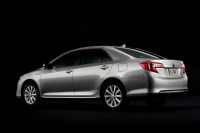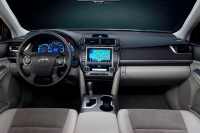After introducing the seventh-generation Toyota Camry and Camry Hybrid in 2012, Toyota decided to keep it for 2013 as well, with improvements in interior design and safety technology.
The Toyota Camry has been America's best-selling car for the past 15 years. The 2013 Camry received an updated design, a roomier interior, improved driving dynamics and a quieter ride than its 2012 predecessor.
The 2013 Camry Hybrid, with a fuel economy of 5.4 liters per 100 kilometers, has also undergone internal improvements. A new, soft-touch material is used on the front door panel in the LE Hybrid as well as the gasoline LE and SE models. On LE-class models, the armrests now match the interior color (previously they were black).
The entry-level models of the 2013 Toyota Camry are L-class, and there are LE, XLE and sporty SE-class models in addition to it. There is a choice of four-cylinder engines for the L and LE models and a V6 for the SE and XLE. The hybrid Camry is offered in two trims: LE and XLE.
First launched in 1983, the Toyota Camry set the standard for midsize sedans by defining the criteria for quality, reliability and safety. Since then, Toyota has sold more than 15 million Camry vehicles worldwide.
Exterior design
The new generation Camry uses a simple yet elegant, modern look that emphasizes the width of the model. This effect is achieved through clear lines and dynamic headlight shapes. Strongly curved sections on the doors give the Camry a distinctive look. Fog lights are standard in the SE and XLE classes.
 The Camry LE and XLE grades use additional chrome trim; in addition, the SE has an exclusive fine mesh grille design for the upper section. The SE also has compartments in the lower panel for fog lights.
The Camry LE and XLE grades use additional chrome trim; in addition, the SE has an exclusive fine mesh grille design for the upper section. The SE also has compartments in the lower panel for fog lights.
Interior design - interior
While the car is virtually the same size as its predecessor, the new generation does offer a more spacious interior. Toyota engineers have optimized interior elements to gain additional space, as well as improved the quality of comfort for the driver and passengers. One example is the steering wheel tilt range, which has been increased by 33% compared to the previous generation model. Rear seat passengers are given 5 cm more legroom.
 A redesigned dashboard structure has reduced its visual mass. Soft textures are used in the upper door trim, door panels and armrests. Soft upholstery and fabrication material help create a sense of luxury. Aluminum colors and chrome finishes are used evenly.
A redesigned dashboard structure has reduced its visual mass. Soft textures are used in the upper door trim, door panels and armrests. Soft upholstery and fabrication material help create a sense of luxury. Aluminum colors and chrome finishes are used evenly.
The LE and XLE classes have ivory and gray upholstery. The SE has unique black or black on gray upholstery. Comfort seats have always been a strong point of the Camry. The new car got higher seat backs and better seat cushions for them.
The 2013 Camry offers four seat trim options: cloth on the LE and XLE, cloth with SOFTEX™ trim on the SE, standard leather trim on the XLE V6, and Ultrasuede leather on the SE and XLE Hybrid. Heated seats are standard on the XLE V6, and are also available on the SE, XLE with four cylinders.
The front console has a 12-volt accessory jack and a USB port for connecting players and other multimedia devices.
Folding rear seats noticeably expand cargo capacity. An armrest with cup holders adds comfort and convenience.
Performance and efficiency
There are three engines to choose from in the 2013 Toyota Camry: a 2.5-liter four-cylinder gasoline engine, a 3.5-liter V6 and Hybrid Drive Synergy. The 2.5-liter with 178 hp and 170 Nm of torque is combined with a six-speed automatic transmission. Fuel consumption in the city is 9.4 liters per 100 kilometers and 6.7 liters per 100 kilometers on the highway.
 2.5-liter engine works with the system Dual VVT-I (Intelligent variable valve timing), which controls the timing of timing on both intake and exhaust valves. The induction control system (ACIS) helps optimize torque over a wide range of engine speeds.
2.5-liter engine works with the system Dual VVT-I (Intelligent variable valve timing), which controls the timing of timing on both intake and exhaust valves. The induction control system (ACIS) helps optimize torque over a wide range of engine speeds.
The 3.5-liter V6 installed in the SE and XLE classes has an output of 268 hp and 248 Nm of torque. In 2012, the engine has been upgraded, reducing fuel consumption to 11 liters in the city and 7.5 liters per 100 km on the highway. The V6 uses a camshaft chain drive system and dual variable valve timing with intelligence (Dual VVT- I).
The Camry Hybrid comes with the Drive Synergy hybrid transmission, which includes a 2.5-liter four-cylinder engine.
By making the car lighter, optimizing the engine and aerodynamics, the updated Camry Hybrid has reduced fuel consumption by 30 percent compared to the original Camry Hybrid.
The 2.5-liter engine uses the Atkinson cycle (delayed intake valve closure to extend the compression ratio) for maximum efficiency. Intelligent Variable Valve Timing (VVT- I) increases torque, which is greater than in the previous engine. Electric water pump, roller-valve-type rocker contribute to reducing internal friction, increasing economy.
Exhaust gas recirculation (EGR) water cooling system helps ensure reduced pollution at high vehicle speeds and helps improve fuel efficiency.
Multimedia capabilities
All models of the new Camry are equipped with Bluetooth for wireless conversation. A standard USB port allows for music and video playback from portable audio devices using the vehicle's sound system.
L-Class and Hybrid LE models have a 6.1-inch screen. In the hybrid model, it also displays energy and fuel consumption, a rearview camera and display functions. The screen serves as a portal to the Entune navigation system.
Top-of-the-line models feature a seven-inch screen with the Entune® navigation system and JBL. This system offers a new split-screen option that can display navigation and audio information at once.
The Camry features the JBL GreenEdge™ audio system, which combines an eight-channel amplifier and door-mounted speakers. The GreenEdge™ amplifier optimizes the sound in the speakers, making them louder while also reducing overall energy consumption.
Driveability and smoothness
The rigid body structure, redesigned rear and front suspension, and improved aerodynamics have improved the car's on-road stability and overall ride comfort.
The car's body uses more high-strength steel than earlier models, resulting in a much lighter overall weight.
The front McPherson struts use special springs that improve stability on straightaways. The damping damper and tire thickness stabilizer have also been optimized. The Dual-Link rear suspension has been redesigned with a new geometry that makes the car feel more stable in sharp corners.
The LE-class models have 16-inch wheels; the SE has five-spoke 17-inch alloy wheels, and the SE V6 model is available with 18-inch alloy wheels. The Camry XLE comes standard with 17-inch alloy wheels.
Safety
All 2013 Camry models are equipped with 10 airbags: front, rear and sides.
The structure of the car is designed to absorb impact energy during a collision and prevent deformation of the passenger compartment. The internal structure of the hood and front end is designed to minimize injury to pedestrians in a collision.
The Star Safety System™ includes Vehicle Stability Control (VSC ), Traction Control System (TRAC), Anti-lock Braking System (ABS), Electronic Brake-force Distribution (EBD) and Brake Assist.
Another safety system, Connect, will help in the event of an accident by alerting the operator, who will in turn contact the police and ambulance. The system combines automatic notification in the event of a collision or stolen vehicle, which will help track the vehicle using the built-in GPS.
The Blind Spot Monitor system helps detect vehicles in the driver's blind spots. When the system detects a vehicle in the adjacent lane, it alerts the driver by flashing the indicators on the side mirrors.
The images from the rearview camera are transmitted to the audio display, helping the driver navigate when reversing or parking the vehicle.


-rear-and-front-view-camera-6.png)

